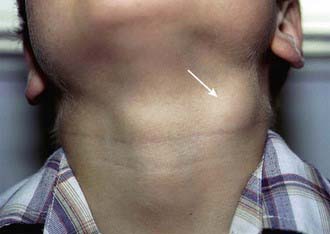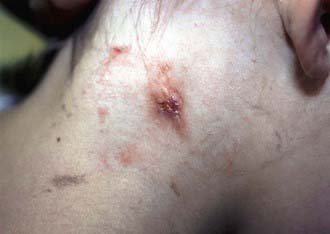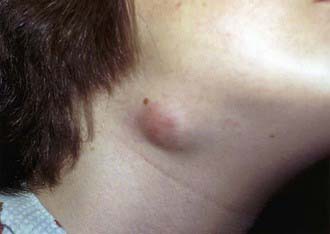Chapter 209 Nontuberculous Mycobacteria
Nontuberculous mycobacteria (NTM), also referred to as atypical mycobacteria or mycobacteria other than tuberculosis (MOTT), are members of the family Mycobacteriaceae and the genus Mycobacterium. Genetically, NTM constitute a highly diverse group of bacteria that differ from Mycobacterium tuberculosis complex bacteria in their pathogenicity, nutritional requirements, ability to produce pigments, enzymatic activity, and drug-susceptibility patterns. In contrast to the M. tuberculosis complex, NTM are acquired from environmental sources and not by person-to-person spread. Their omnipresence in our environment implies that the clinical relevance of NTM isolation from clinical specimens is often unclear; a positive culture might reflect contamination rather than true NTM disease. NTM are associated with pediatric lymphadenitis, otomastoiditis, serious lung infections, and, albeit rarely, disseminated disease. Treatment is long-term and cumbersome and often requires adjunctive surgical treatment. Guidelines on diagnosis and treatment are provided by the American and British Thoracic Societies.
Etiology
NTM are ubiquitous in the environment all over the world, existing as saprophytes in soil and water but also as opportunistic pathogens in animals, including swine, birds, and cattle. Many of the 130 validly published NTM species have been isolated from environmental and animal samples, implying that humans are constantly exposed to NTM from the environment, for instance during showering. Owing to the introduction of molecular identification tools such as 16S rDNA gene sequencing, the number of identified NTM species has grown to more than 130; the clinical relevance (i.e., the percentage of isolates that are causative agents of true NTM disease, rather than contamination) differs significantly by species.
In the USA, M. avium-intracellulare complex (MAC) and M. kansasii are most often isolated from clinical samples, yet the isolation frequency of these species differs significantly by geographical area. MAC bacteria have been commonly isolated from natural and synthetic environments in the USA, and cases of MAC disease have been successfully linked to home exposure to shower and tap water. Although the designation M. avium suggests that M. avium infections are derived from birds (avium being Latin for “of birds”), molecular typing has pointed out that M. avium strains that cause pediatric lymphadenitis and adult pulmonary disease represent the M. avium hominissuis subgrouping that is mainly found in humans and pigs and not in birds.
Some NTM have well-defined ecologic niches that help explain infection patterns. The natural reservoir for M. marinum is fish and other cold-blooded animals, and hence infections due to M. marinum follow skin injury in an aquatic environment. M. fortuitum complex bacteria and M. chelonae are ubiquitous in water and have caused clusters of nosocomial surgical wound and venous catheter–related infections. M. ulcerans is associated with severe, chronic skin infections (Buruli ulcer disease) and is endemic mainly in West Africa and Australia, although other foci exist. Its incidence is highest in children <15 yr old. Mycobacterium ulcerans had been commonly detected in environmental samples by polymerase chain reaction (PCR) but was only recently recovered by culture from a Water Strider (Gerris sp.) from Benin.
Epidemiology
Humans are exposed to NTM very commonly. In rural counties in the USA, where M. avium is prevalent in swamps, the prevalence of asymptomatic infections with M. avium complex as measured by skin test sensitization approaches 70% by adulthood. Still, the incidence and prevalence of the various NTM disease types remain largely unknown, especially for pediatric NTM disease. In Australian children, the overall incidence of NTM infection was found to be 0.84 per 100,000, with lymphadenitis accounting for two thirds of cases. The incidence of pediatric NTM disease in the Netherlands has been estimated at 0.77 infections per 100,000 children per year, with lymphadenitis making up 92% of all infections.
In comparison, estimations of the prevalence of NTM from respiratory samples in adults are 5-14.1/100,000 persons per year, with important differences between countries or regions. Because pulmonary NTM disease progresses slowly, over years rather than months, and usually takes several years to cure, the prevalence of pulmonary NTM disease is much higher than incidence rates would suggest.
The paradigm that NTM disease is a rare entity limited to developed countries is changing. In recent studies in African countries with a high prevalence of HIV infection, it has been found that NTM might play a much larger role as a cause of tuberculosis-like disease of children and adults than previously assumed.
Pathogenesis
The histologic appearances of lesions caused by M. tuberculosis and NTM are often indistinguishable. The classic pathologic lesion consists of caseating granulomas. Compared with M. tuberculosis infections, NTM infections are more likely to result in granulomas that are noncaseating, ill defined (nonpalisading), and irregular or serpiginous. Granuloma formation during NTM disease might even be absent, with only chronic inflammatory changes observed.
In patients with AIDS and disseminated NTM infection, the inflammatory reaction is usually scant and tissues are filled with large numbers of histiocytes packed with acid-fast bacilli. These disseminated NTM infections typically occur only after the number of CD4 T-lymphocytes has fallen below 50/µL, suggesting that specific T-cell products or activities are required for immunity to mycobacteria.
The pivotal roles of interferon-γ (IFN-γ), interleukin (IL)-12 and tumor necrosis factor (TNF)-α in pathogenesis are demonstrated by the high incidence of (mostly disseminated) NTM disease in children with interferon-γ and IL-12 pathway deficiencies and in persons treated with agents that neutralize TNF-α.
Observed differences in pathogenicity, clinical relevance, and spectrum of clinical disease associated with the various NTM species emphasize the importance of bacterial factors in the pathogenesis of NTM disease, though exact virulence factors remain unknown.
Clinical Manifestations
Lymphadenitis of the superior anterior cervical or submandibular lymph nodes is the most common manifestation of NTM infection in children (Table 209-1). Preauricular, posterior cervical, axillary, and inguinal nodes are involved occasionally. Lymphadenitis is most common in children 1-5 yr of age and has been related to their tendency to put objects contaminated with soil, dust, or standing water into their mouths. Given the constant environmental exposure to NTM, the occurrence of these infections might also reflect an atypical immune response of a subset of the infected children during or after their first contact with NTM.
Table 209-1 DISEASES CAUSED BY NONTUBERCULOUS MYCOBACTERIAL SPECIES
| CLINICAL DISEASE | COMMON SPECIES | LESS-COMMON SPECIES |
|---|---|---|
| Cutaneous infection | M. chelonae, M. fortuitum, M. abscessus, M. marinum | M. ulcerans* |
| Lymphadenitis | MAC | M. kansasii, M. haemophilum, M. malmoense† |
| Otologic infection | M. abscessus, MAC | M. fortuitum |
| Pulmonary infection | MAC, M. kansasii, M. abscessus | M. xenopi, M. malmoense,† M. szulgai, M. fortuitum, M. simiae |
| Catheter-associated infection | M. chelonae, M. fortuitum | M. abscessus |
| Skeletal infection | MAC, M. kansasii, M. fortuitum | M. chelonae, M. marinum, M. abscessus, M. ulcerans* |
| Disseminated | MAC | M. kansasii, M. genavense, M. haemophilum, M. chelonae |
MAC, Mycobacterium avium complex.
† Found primarily in Northern Europe.
From American Academy of Pediatrics: Red book: 2009 report of the Committee on Infectious Diseases, ed 28, Elk Grove Village, IL, 2009, American Academy of Pediatrics, p 703.
Affected children usually lack constitutional symptoms and present with a unilateral subacute and slowly enlarging lymph node or group of closely approximated nodes >1.5 cm that are firm, painless, freely movable, and not erythematous (Fig. 209-1). The involved nodes occasionally resolve without treatment, but most undergo rapid suppuration after several weeks (Fig. 209-2). The center of the node becomes fluctuant, and the overlying skin becomes erythematous and thin. Eventually, the nodes rupture and form cutaneous sinus tracts that drain for months or years, resembling the classic scrofula of tuberculosis (Fig. 209-3).

Figure 209-1 An enlarging cervical lymph node infected with Mycobacterium avium complex infection. The node is firm, painless, freely movable, and not erythematous.

Figure 209-3 A ruptured cervical lymph node infected with Mycobacterium avium complex, which resembles the classic scrofula of tuberculosis.
In the USA, M. avium complex accounts for approximately 80% of NTM lymphadenitis in children. Birds are an unlikely source of these M. avium complex infections, as molecular typing has shown that the lymphadenitis-associated M. avium bacteria are of the human or porcine subtype rather than the bird type. M. kansasii accounts for most other cases of lymphadenitis in the USA. M. malmoense and M. haemophilum are described. The former is only common in northwestern Europe; for the latter, underestimation is likely because the bacteria require specific culture conditions (hemin-enriched media, low incubation temperatures). On the basis of PCR analysis of lymph node samples from lymphadenitis cases in the Netherlands, M. haemophilum was the second most common cause of this infection after M. avium complex.
Cutaneous disease caused by NTM is rare in children (see Table 209-1). Infection usually follows percutaneous inoculation with fresh or salt water contaminated by M. marinum.
Stay updated, free articles. Join our Telegram channel

Full access? Get Clinical Tree



